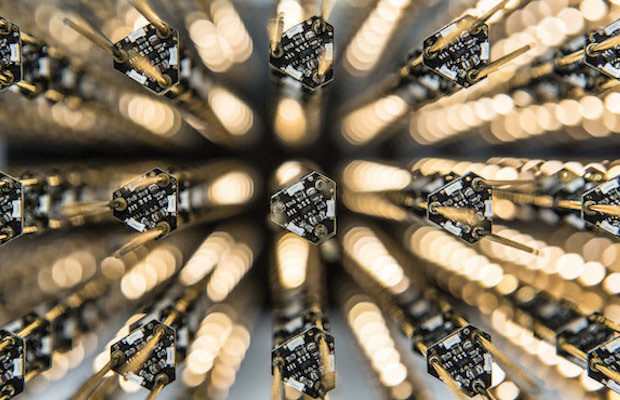Use your ← → (arrow) keys to browse
Ingo Maurer

TOM VACK PHOTOS/© INGO MAURER GMBH
Ingo Maurer, arguably the most famous lighting designer of our time, became one by a twist of fate. He started his career working in graphics. “I believe in what the French call hasard, that chance rules us,” he says. “I was staying in a pensione in Venice and I saw a light bulb dangling overhead. I had had a good meal and a bottle of wine and I thought, ‘the bulb is beautiful; we have to honor it.’ I went to a glassmaker. That’s how it started.”
The result, Bulb, an oversize blown-glass light bulb set on a chrome-plated base that houses a conventional incandescent one, was introduced to the world in 1966 and was an instant success, quickly establishing Maurer as a force to be reckoned with. Today Bulb brings five-figure prices in the secondary market. But that was just the beginning of the story. With a decades-long career under his belt—he celebrated his company’s fiftieth anniversary last year—the designer, who will turn eighty-five in May, is still at the top of his game. Strikingly tall with a mane of white hair, he exudes a hypnotic warmth.

TOM VACK PHOTOS/© INGO MAURER GMBH
He has produced an amazing body of work—all of it distinguished not only by sheer beauty, romantic passion, and wit, but also by innovation. Maurer has been responsible for a host of groundbreaking technologies, from the first low-voltage lighting system with cables and halogen bulbs, YaYaHo, which he introduced in 1984, to his pioneering work with LEDs, creating the very first residential LED lamp, Bellissima Brutta, in 1997. He has made wallpaper with built-in circuitry and LED lights that slowly change colors and patterns. His widely exhibited Wo bist du, Edison, jetzt wo wir dich brauchen? is believed to be the first 360-degree hologram ever created. It plays with holograms as a source of light. In the last ten years he has been experimenting with OLEDs (organic light-emitting diodes), the latest technological advance in the rapidly changing world of illumination. Vico Magistretti, the late Italian design maestro, wrote of Maurer: “Ingo uses technology as a means of expressing a new sense of beauty . . . . His objects convey a strong sense of humor, which is ultimately poetic.”

TOM VACK PHOTOS/© INGO MAURER GMBH
The Munich-based designer creates more than residential lighting. He first exhibited non-commercial work at Fondation Cartier pour l’Art Contemporain in 1989. Since then, he has created a multitude of specially commissioned pieces for both public spaces and private clients, including a fashion show and London showroom for Issey Miyake, subway stations in Munich, and a giant snow flake for UNICEF in New York. Maurer has had countless museum shows throughout Europe, Asia, and the United States, and has recently opened an exceptional showroom in Brazil.
He is something of an anomaly among the current global giants of design. By setting up his own company he has been completely autonomous, responsible to no one but himself. His sixty-plus employees, whom he calls his team, are always scrupulously credited for their contributions. Maurer is never tempted to outsource production. He feels a moral obligation to his staff; he is supporting what he calls his “family.”
Successfully in business for five decades, he has never had a marketing plan. Intuition is his guiding star. Maurer frequently quotes Albert Einstein’s dictum, “Intuition is more important than intelligence. Without intuition, innovation is impossible.”
-Arlene Hirst
Use your ← → (arrow) keys to browse
 COURTESY CARPENTERS WORKSHOP GALLERY
COURTESY CARPENTERS WORKSHOP GALLERY













